Using Oil as a Facial Moisturiser (+ A DIY Recipe for When Oil Alone is Not Enough)
I never thought I was a sucker for marketing. But when it came to beauty products, I used to spend a fortune buying products with names I didn’t understand (but sounded fancy) from department store beauty counters. You know those counters, the ones with the ladies wearing lab coats (oooh, how science-y!).
I thought those products were better for my skin. Plus they looked so luxurious, with all that (plasticky, single-use) packaging.
{Cringe.}
When I decided to go plastic-free, I realised that rather than trying to replace all of the products in my bathroom, it would be better for my sanity (and success rate) if I chose to simplify. Meaning, less products. I’ve talked about the switches I made and my natural skincare regime before, but today I wanted to focus on one aspect of that: moisturizer.
I used to buy an eye cream, a day cream, a night cream, and body lotion. Maybe after-sun in summer. It makes me laugh (or cry, perhaps) to tell you that, because I didn’t think I was a high-maintenance woman. Those marketing peeps got me good.
Rather than try to find 5 alternatives without packaging, I decided to go for one simple swap to replace all of them. Rather than using moisturiser, I switched to oil.
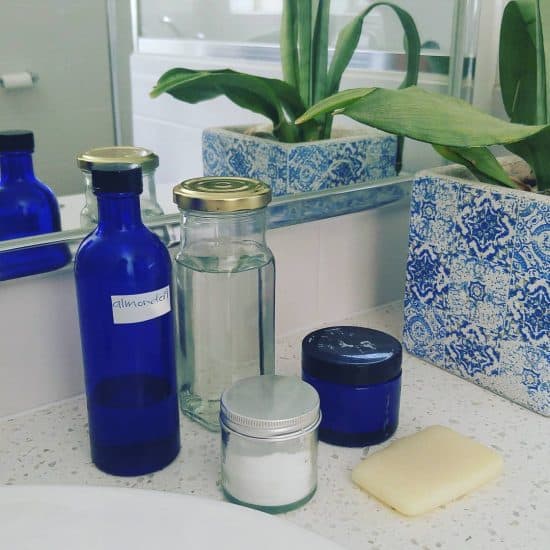
Using Oil as a Moisturiser
When I say I use oil as a moisturiser, I mean oil as a single ingredient. I do not mean oil-based products or oil blends that contain other chemicals.
The staple oil I use as moisturiser is sweet almond oil. It is easy to find in bulk, absorbs well, is a neutral colour and has a very mild fragrance.
I have also used jojoba oil, rosehip oil, olive oil, hemp seed oil, coconut oil and shea butter. Jojoba oil is thought to most closely mimic the skin’s natural sebum. Rosehip oil is great, and apparently has anti-aging properties but is more expensive. Olive and hemp seed oil have a slightly green colour and need to be thoroughly rubbed in to avoid a green tinge. Coconut oil and shea butter are more effort to apply (both are solid at room temperature).
One of the other properties that differs between oils is their ability to block pores. Oils are graded on their ability to block pores, known as their comedogenic rating. (A comedone is a plug of dirt, bacteria and oil that blocks a pore and causes a spot: usually a blackhead but sometimes a whitehead).
Ratings vary from 0 (will not clog pores at all) through to 5 (likely to clog pores).
Almond oil, jojoba oil and olive oil are all graded 2, which means they have a moderately low chance of clogging pores. Rosehip oil is rated 1; hemp seed oil and shea butter are non-comedogenic with a score of 0. Coconut oil has a score of 4, and some people who use coconut oil find they do break out in spots.
People with dry skin tend to have smaller pores, and are more suited to oils with a lower comedogenic rating (2 or below). I have dry skin and almond oil works fine for me.

Does using oil make your skin oily? Actually, no.
I know that sounds counter-intuitive. But our skin produces its own natural oil, called sebum. It is produced to lubricate, waterproof and protect the skin. The absolute worst thing we can do is use cleansers and chemicals to try to strip this oil from our skin. That just makes our skin react, and produce more sebum.
Using oil doesn’t strip this sebum, and doesn’t stimulate the skin to produce more. Some people do produce more sebum than others, but that is due to more active sebaceous glands.
Using oil as moisturiser will not make your skin oily.
Oil can make the skin shiny, at least until the oil is absorbed. If shiny-ness is something you care about, a simple face powder will sort that out.
Rather than make the skin oily, using oil can make your skin dry out, particularly if you are prone to dry skin, as I am. I’ve talked about this below, and what to do if this happens.
Tips for Using Oil as Moisturiser More Effectively

Although I say I use oil as a moisturiser, oil does not actually contain moisture. It works as a barrier on the skin, preventing moisture loss. For most of the year this is fine, but in winter, when heating, extra hot showers and exposure to cold winds causes my skin to dry out, the oil cannot add moisture back in.
In contrast, most moisturisers are oil blended with water and stabilised with emulsifier. When they are applied they add moisture to the skin, and the oil acts as a barrier to keep it there.
When I start to notice dry patches on my skin, applying oil alone does not hydrate my skin. It appears to work temporarily, but the dry skin returns. There are some things that I do to help hydrate my skin.
Apply Oil Before Showering
In winter I always apply oil to my face before showering. This provides a barrier to stop the hot water and steam drying out my skin.
Avoid Soap or Soap-Based Cleansers
I use soap on my face very rarely in winter, and do not use it on my body every day. Instead, I use water and oil. Oil cleansing is an age-old method of cleansing, working on the premise that like dissolves in like. Grease and dirt on the skin are replaced with clean oil. It is as simple as putting a small amount of oil on the skin, and then wiping off with a flannel.
Apply Oil After Showering, But Before the Skin is Completely Dry
When I get out of the shower, I blot my skin dry with a towel but I always apply oil to my face before my skin is completely dry. If it has already dried, then I splash water on my face before applying oil. It is harder to rub in as the oil and water don’t like each other, but it leaves my skin much more moisturised.
Drink More Water
This is definitely a case of “do as I say, not as I do” because in my world, I’m constantly realising that it is 4pm and the only thing I have drunk all day is coffee. But I do know that drinking water is good for the skin, and I definitely notice the difference when I drink more water.
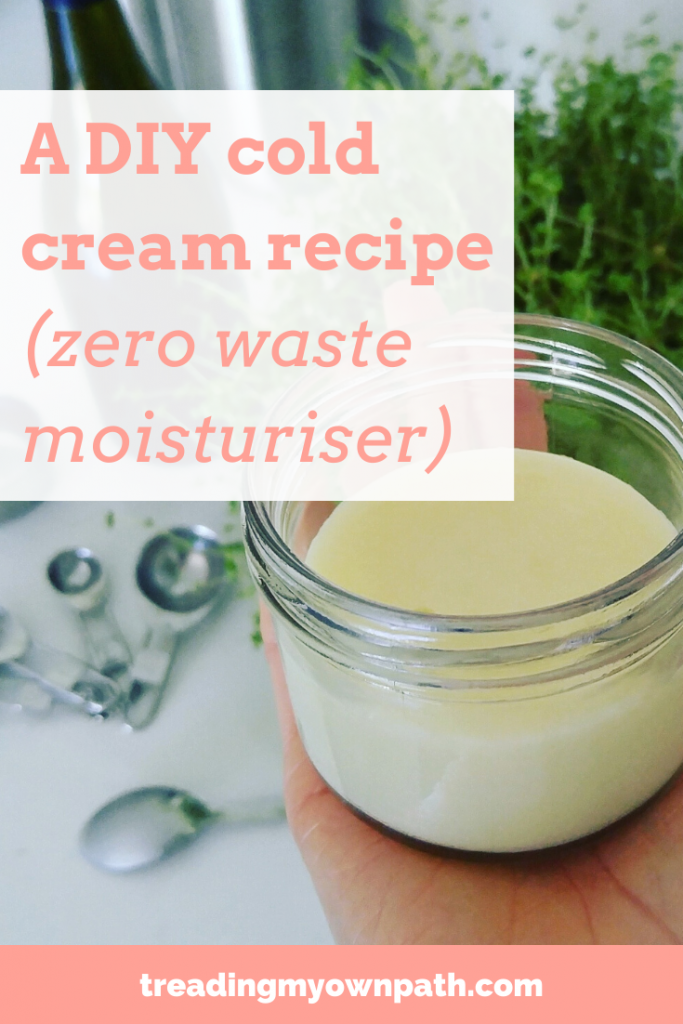
When Oil Really Isn’t Enough
Last winter was particularly cold, and my skin got very dry. I didn’t know back then that oil alone wasn’t going to hydrate my skin. I’d apply more and more oil, slathering it on thicker and thicker, and my skin just got drier and drier.
Eventually I realised I needed something with a little more oomph.
I’ve messed around with a few DIY moisturisers and balms, but the one I come back to often is cold cream. Cold cream is a water-in-oil type of emulsion (whereas most moisturisers are oil-in-water emulsions). Being oil in water, it is soothing and cooling on the skin.
Cold cream can be used as a cleanser, make-up remover, face mask or moisturiser. I’m a big fan of products with multiple uses.
The recipe I use is based on a recipe by Aelius Galenus, a Greek who was born in 129AD. Definitely a recipe that has been handed down through generations!
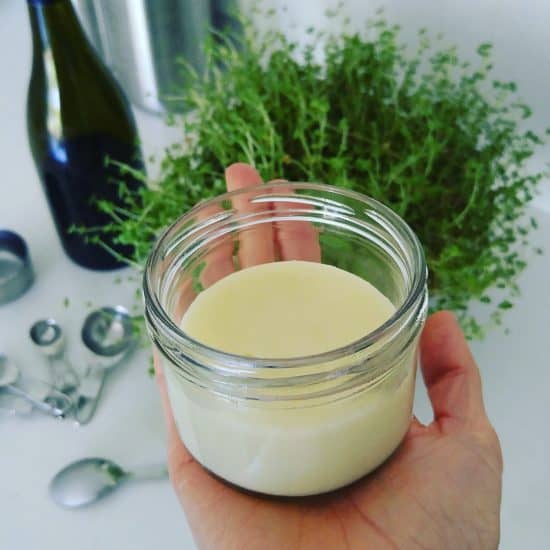
Galen’s Cold Cream Recipe
INGREDIENTS:
75 ml rose water / distilled water / rain water
15 g beeswax (2 tablespoons)
90 ml olive oil / almond oil
4 drops rose geranium essential oil
Optional: 2 drops vitamin E (vitamin E is a natural preservative)
METHOD:
Heat the rose water in a bowl over a pan of hot water.
Place beeswax and olive oil in a separate bowl over a pan of hot water, and melt. Remove from the heat and pour the rosewater into the melted oil, using a whisk to mix together. (Please be careful as melted oils become very hot and can cause burns.)
As the mixture begins to cool, it will turn opaque. Add the essential oil (and vitamin E, if using) and pour into a glass jar. Use within 6 months.
NOTES: Vitamin E is a preservative, so omitting this might shorten the shelf life of the product. If you are vegan, two alternatives to beeswax are candelilla wax and carnauba wax, which are both palm oil free. They are harder than beeswax so half the amount (1tbsp rather than 2tbsp) if using these waxes.
This cold cream cleared up my dry skin patches within days. Whilst I still use oil as my main moisturiser, I now use cold cream as an extra boost in the winter months, particularly if I am going to be outside.
Now I’d love to hear from you! What is your skincare routine? Do you use oil as a moisturizer? Which is your favourite? Do you make your own moisturiser? Is there a brand that you buy and love? Any other thoughts or questions? Join the conversation and leave a comment below!
[leadpages_leadbox leadbox_id=1429a0746639c5] [/leadpages_leadbox]
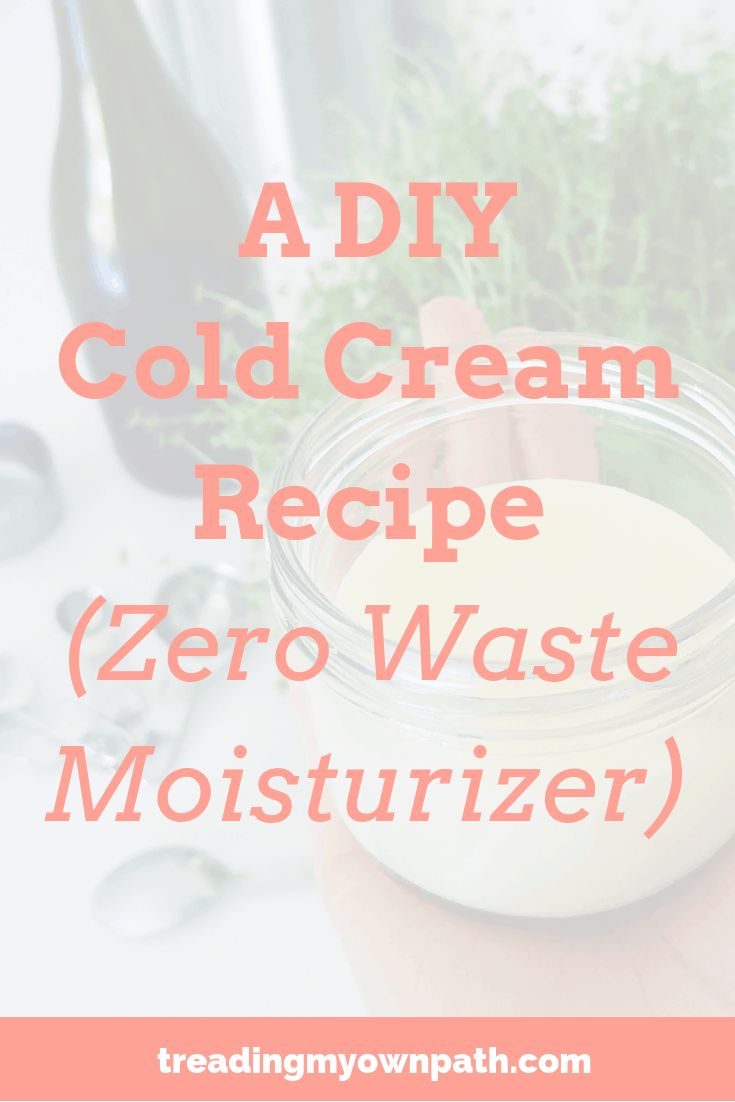

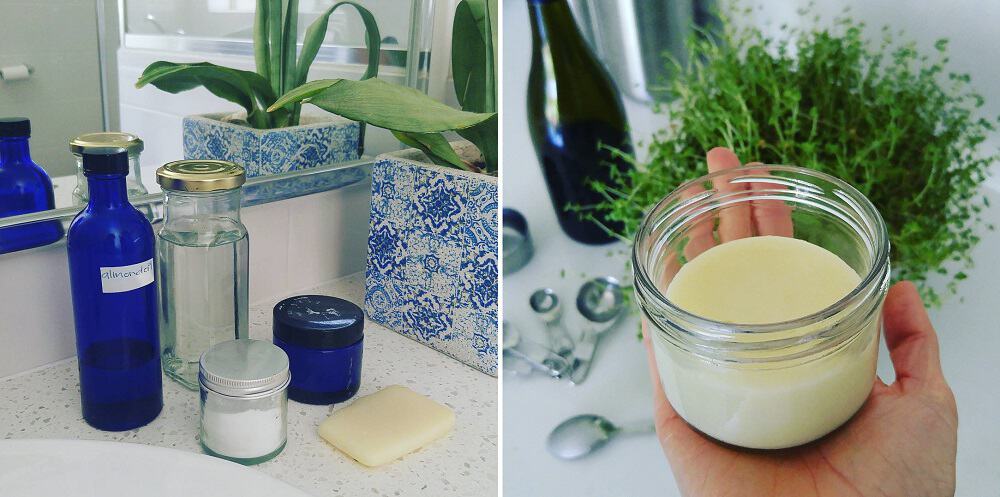




Love these tips! I have been using a oil/honey/sugar recipe as an exfoliant and it is magical. I live in the desert so it is important to keep my skin hydrated. I’m going to try almond oil pre shower to try to soak up as much goodness as I can! Thanks for sharing.
Pleasure Lindsay! I love natural products for skin too, I can’t believe I ever used to purchase those chemical-laden plastic bottles!
I lik Ethique. Their moisturiser works for me and it comes in a cardboard packet!
I didn’t realise they did moisturiser Ann, I thought they just did shampoo and conditioner. Good to know! I have to say I’ve never tried their products, but I do recommend them to people because I love their ethos and so many of my readers think they are great. Love it when a company ticks all the boxes!
G’day Lindsay, I am on the hunt for foundation and concealer, have you had any luck in this direction?
Thanks
Hi Susan! don’t wear make-up much myself but I know lots of people have success on Etsy so maybe have a look there?
Thanks, I’ll have a gander around on Etsy :-)
I like dirty hippie cosmetics on etsy
Does beeswax clog pores?
Hi Katie, I just asked Google and Google said no :)
That recipe sounds simple enough, I think I’ll have to try that some day – thanks!
My current moisturizer is a mixture of Urtekram’s body lotion and varying oils (Lavera’s baby&kinder oil, coconut, argan, almond) depending on what I happen to have at hand. This habit actually started by accident when there once was about a half a deciliter of body lotion in the bottom of bottle that refused to come out. I figured that if I add some oil in there, it’ll become more fluid and I can get it out and to use. It turned out that this mixture worked better on my (dry) face than many actual moisturizers and so I have ended up using only it for quite a few years now.
By the way, I also have a personal experience on how effective oils can be in skincare: It must have been almost ten years ago when I first read about the benefits of oils in skincare and thought I should try it. At the time I had an insistent pimple on my chin that had kept popping back every month (hormonal acne) for a year or two (yes, we are talking about YEARS!!!) and always to the exact same pore. Lavera’s baby&kinder oil was cheap and easily available at the time, so I bought and started using that as moisturizer and next month – I’m pretty sure you can guess what happened – the pimple had disappeared for good! Before trying the oil I had thought that the pimple would be there forever, or at least until menopause, but I haven’t seen it since. Pretty amazing, don’t you think?
I like your haphazard approach, Eija, it’s a little like mine ;) Oils are great, I just wish I’d made the switch years ago! Glad you successfully fought your pimple, and without any nasties!
I can sometimes use almond oil alone as a moisturizer, but in the winter time my skin needs a bit more. I’ve also been experimenting with DIYs using beeswax, rosehip oil, evening primrose oil, vitamin E, and shea butter. I love your idea of using oil before getting in the shower – steam and hot water wreak havoc on my skin!
Hi Emma, yes I’ve found it really helpful. I apply before and after. Definitely makes a difference!
I apologize if I sound annoying, but there’s no water in oil, so it can’t moisturize/hydrate the skin. Oil nourishes the skin, which is good, but may not work on skins that need moisture. Aloe vera gel and honey do moisturize. Each person needs to figure out if his/her skin is hungry or thirsty, or both to various degrees. I have very dry skin, and oil only doesn’t help (my skin gets very uncomfortable and flaky with just oil).
Hi Sophie, you do not sound annoying at all, that is exactly what I said in the post above! Oil doesn’t contain moisture so can’t moisturize.
I also think the point you make about everyone having different skin is sooooo true. What works for one most definitely doesn’t work for everyone! Another reason why I love the DIY approach. That way we can adapt to exactly what we need :)
Sounds great overall but how do you manage to protect your skin from the sun when oils and sun rays lead to a higher sunburn risk….? I wear sunscreen everyday to prevent sun spots/skin cancer risks etc…and the most natural ones I can find are things like WotNot, Jurlique and Nude…what is your ‘natural’ take? Would love to know your thoughts!
Hi Jos, good question. I wear sunscreen, I make my own with zinc powder and have a recipe here for the one I use: https://treadingmyownpath.com/2016/05/19/plastic-free-zero-waste-natural-sun-cream/ (I also talk about how you can’t calculate your own SPF and bought alternatives.)
I tend to wear sunscreen only when going in the sun for extended periods e.g. gardening. I try to cover up, keep out of the sun at midday, and oil has a very low SPF (4-8, depending on the oil), I’m not sure it has an increased sunburn risk and I definitely haven’t noticed it myself…
Hope that helps!
One of the main reasons I use commercial face moisturizer is for the SPF. Do you have any suggestions there?
Hi Laura, you could add a small amount of zinc powder to a cold cream moisturiser. I’ve written about sunscreen and zinc powder in more detail here: https://treadingmyownpath.com/2016/05/19/plastic-free-zero-waste-natural-sun-cream/
Ethique! Bars no bottles. And it is for shampoo,face cleaner,face moisturizing etc!
I thought Ethique only did shampoo and conditioner Ellen! So good to know :)
I have made my own facial oil for over 30 years (I studied aromatherapy) and I use sweet almond oil as my base oil with geranium, sandalwood and lavender essential oils (occasionally jasmine for décolleté if I want a perfume). Egyptian mummies, thousands of years old, were found to have been preserved using essential oils, so skin was still present. If it was good enough for them, it’s good enough for me!!
That’s great Suzel – the Egyptians were onto something it seems ;) I find oil feels so much better than petroleum based chemicals. Both on the skin, and also on the conscience :)
I have been using this recipe (hello Western Earth Carers!), albeit with normal tap water. With me I find that after setting, the water tends to separate from the oil. It’s still usable as a moisturiser, but I’m wondering if I do anything wrong. Any tips?
Hi Bernadette! I noticed this with one big jar I left for several months. Are you adding vitamin E? I think the nearer the temp of the two different liquids are to one another, the better they combine. I don’t think it separately slightly affects the properties of the cream though, it just doesn’t look quite as good!
Hi Lindsay, I just made this cold cream but after whisking, when I poured it into a jar the water separate from the oil and beeswax after a few minutes.
So there’s water on the bottom and oil+beewax on top.
What am I doing wrong?
I do so love the amount of detail in your posts :) I’m confused about your emulsion description though – why does it make a difference if the product is a water-in-oil, or oil-in-water emulsion?
Hi Rachel! I don’t know a lot about water-in-oil versus oil-in-water emulsions, other than that they are different, and have different properties. One is water suspended in oil; the other is oil suspended in water. Water-in-oil creams don’t disappear into the skin like oil-in-water ones, for example. Sunscreen tends to be water-in-oil also. There’s a lot of chemistry behind it which is quite interesting to me, but didn’t make it into the post!
Sounds almost like the cream I use for my baby. I mix olive oil (in which I soaked marigold for a few minutes) and beeswax and a little bit coconut oil.
All the “normal” bought products cannot calm this sensitive baby skin so super effective like mine.
Thanks for sharing! The main difference is that the cold cream contains water. I shudder at what is in the “normal” products!
I have been using my own home pressed olive oil for my skin for many years, I infuse it with different herbs and plants to get different benifits. I add beeswax to make a cream.
Olive oil is a natrual sunscreen too so for those worried about sun damage or the growing research pointing to sunscreens causing cancer, it is a good oil to condider.
Olive oil is great, Heather! I think the SPF is only about 7 though, so good for incidental sun but probably not a day at the beach at the height of summer!
Thanks Lindsay I have made this moisturiser and so far so good! It’s very timely as I was hunting down the only package free moisturiser at Lush lately and they are out of stock of it in so many stores (Full of Grace Serum FYI) so this is a good alternative!
Hurrah! That’s great Erin!
raspberry seed oil has pretty high natural SPF 25 or so. lavender and carrot seed do to, but not so high.
That’s true about raspberry seed oil, but I haven’t been able to track it down anywhere! Carrot seed oil doesn’t have that high an SPF, it seems to be one of those internet myths (I’ve lost the link I had about this, but I remember it took ages to track down the truth about it).
Thing is though, we tend to use a couple of drops of essential oil, so unless we are coating ourselves in raspberry seed oil, it isn’t going to work as an SPF. And carrot seed oil stinks, the smell is so overwhelming, even a couple of drops is too much! They have lots of other great properties, but relying on them for sun protection isn’t something I recommend.
I would love to know what function the beeswax plays in these recipes. It seems like it would clog your pores, but I’m guessing it seals moisture. Thank You! Gonna try this recipe.
Beeswax doesn’t clog pores. It helps thicken lotions (it’s solid at room temp) and acts as a barrier for the skin. Let me know how you get on!
Hi I made this recipe tonight so thanks for sharing. It is quite thick and I think it may be really good or extra dry places like my elbows, knees and heels. I use Avon face moisturizer because it has alpha and beta fruit acids.. Comes in glass jars which I reuse and also Vitamin C serum which is amazing.
Hi Nadine, yes it’s very thick, it works for my dry skin :) Also good for hands, feet etc, or for using as a cleanser. Multi use, exactly what I love!
Hi Lindsay! Thanks for this post, I found it really useful :) How do you get the oil to not separate from the water as the Cold Cream cools down?
I just keep whisking constantly until it thickens, cools and changes colour to opaque. Seems to work :)
Hey Lindsay, I want to make this but don’t want to buy a whole tub of Vitamin E capsules… is there an alternative way to buy Vit E? Thank you!
Hi Katie! I got mine as a refill from a lady who makes her own products and sells essential oils. She just filled a 50ml bottle for me :)
Have you ever tried Macadamia Oil?
Hi Naomi, I use for cooking but haven’t used as moisturiser. No reason why it wouldn’t work, though!
Hi Lindsay,
You have shared excellent information on this page with the outstanding steps to eliminate the dryness w from the Sensitive skin of body. My suggestion is you take care of skin and avoid to work in a light of sun. You also use a mask on the face if necessary to work in the light of sun and also use carrot in the food salad .
Thanks.
My pleasure, and thanks for your suggestions :)
Thanks for sharing useful information with us, I really got knowledge from this blog. We also provide best olive oil for wrinkles, scars, dryness and skin tone. So Keep posting…
Thanks :) Glad you found it helpful!
Hi there, Great tips thanks. I have been using plain Jojoba oil on my skin for some time now.
However I never realised that it doesn’t actually hydrate the skin.
So I would like to try the cold cream ( I have a combination skin type)
Questions:
Would this cream be too oily for me?
Can the olive oil be replaced with Jojoba oil?
Thank you!
Looking forward to hearing from you!
Hi I am working to make a right moisturizer for my skin… was wondering Are you aware if any of the oils and butters, beeswax should not be mixed?
Hi, Thanks for this recipe. As a long term oil user and eczema sufferer its great to find something I can make at home for when things get a little drier!
I made this last night and 8 hrs later the rose water has separated out of the mixture. I know I put a little too much beeswax in but could i have done something else wrong? Also could the rose water be swapped out for a plain distilled water? I just generally don’t like the smell.
Hi Lindsay. I’ve made your cold cream & like it a lot, particularly it’s simplicity. However it has separated….what am I doing wrong? The top three quarters is solid & then watery on the bottom quarter.
Grape seed oil is fantastic for acne prone skins!
I have found that too. I have made this cream a few times and it always separates.
Vitamin E it’s not a preservative, it’s an antioxidant. These are two very different thing. Antioxidants just slows down the oxidation process.
Nice Blog. A natural olive oil face cream that provides your skin with vitamins, minerals, and antioxidants. Use it daily for a soft, elastic, and glowing skin. The beauty benefits of the olive oil and the organic shea butter will leave your skin feeling clean and soft. Great for dry skin. Order Now!